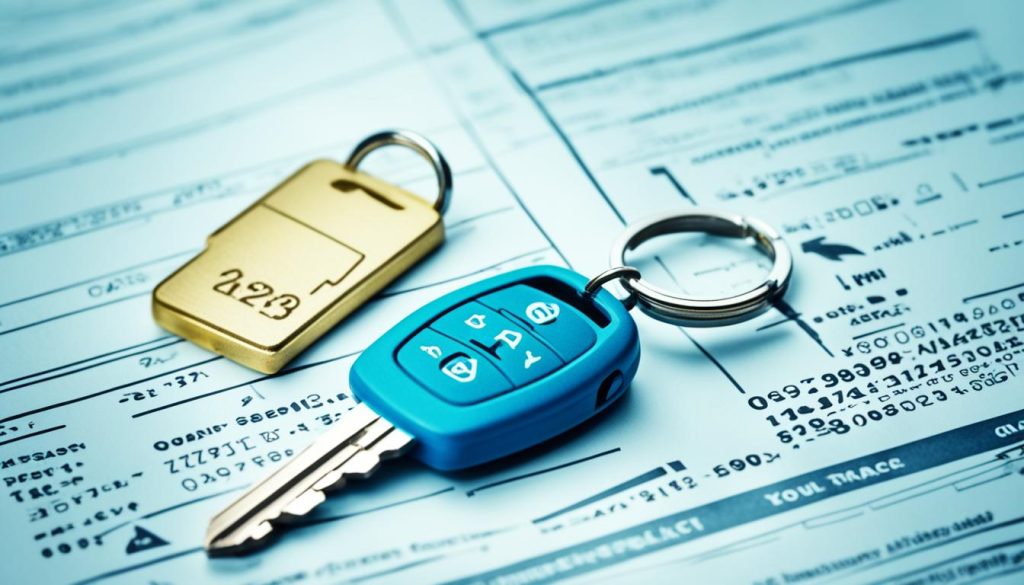You can hit the road with confidence by decoding the complexities of auto insurance
Car insurance is an essential aspect of owning a vehicle. However, the complexities of auto coverage can often leave drivers feeling overwhelmed and confused. Understanding the intricacies of automobile insurance policies is vital for ensuring that you have the necessary protection for your car or vehicle.
Whether you are a seasoned driver or a new car owner, familiarizing yourself with the different types of coverage and the terms associated with auto insurance can help you make informed decisions and navigate the insurance landscape with confidence.
From liability insurance to comprehensive coverage, it’s important to know the ins and outs of your automobile insurance policy. By decoding the key components and terms, you can ensure that you are adequately protected in case of an accident or unforeseen event.
Key Takeaways:
- Understanding the intricacies of auto insurance policies is crucial for confident road travel.
- Decoding the terms and components of your policy can help you determine the level of coverage and protection you need.
- Third-party premiums play a significant role in car insurance, so it’s essential to comprehend how they work.
- Knowing the key terms in your policy, such as premium, deductible, and coverage limit, can prevent any surprises during the claims process.
- By taking the time to understand your car insurance policy, you can make informed decisions, protect your assets, and travel with peace of mind.
Understanding Third-Party Premiums in Car Insurance
When it comes to car insurance, it’s essential to understand the intricacies of third-party premiums, also known as TP premiums. These premiums play a crucial role in determining the level of liability coverage in your comprehensive car insurance policy.
Third-party liability insurance is included in comprehensive car insurance to cover damages and injuries caused to others. This coverage protects you financially if you are found responsible for an accident and need to compensate a third party for their losses.
Understanding how TP insurance works and the factors that influence TP premiums can help you make informed decisions to protect both your vehicle and yourself. Several factors affect TP premiums, including the make, model, and age of your car.
By balancing TP premiums with your overall coverage, you can ensure that you have adequate protection against third-party claims. It’s important to carefully evaluate your insurance needs and consider add-on covers to enhance your liability coverage.
| Factors Influencing TP Premiums | Description |
|---|---|
| Car Make, Model, and Age | The make, model, and age of your car determine its overall value and repair costs, which can impact TP premiums. |
| Driver’s Age and Experience | Youthful and inexperienced drivers often pose higher risks, leading to higher TP premiums to cover potential liabilities. |
| Geographical Location | TP premiums can vary depending on the area’s traffic congestion, crime rates, and accident frequency. |
Remember, having comprehensive car insurance with adequate third-party liability coverage is crucial for your financial security on the road. By understanding TP premiums and the factors that influence them, you can make well-informed decisions to protect yourself and others.
Stay tuned for our next section, where we will explore the key components that make up your automobile insurance policy.
Key Components of Your Automobile Insurance Policy
Your automobile insurance policy consists of several key components that provide you with essential coverage and protection on the road.
Liability coverage: This component protects you in case you are at fault in an accident and covers the costs associated with bodily injury or property damage to others. It ensures that you have the financial means to compensate for any harm caused by your actions.
Collision coverage: Regardless of fault, collision coverage covers the damage to your vehicle resulting from a collision with another vehicle or object. This component ensures that you can repair or replace your car, keeping you on the road.
Comprehensive coverage: Comprehensive coverage provides protection against non-collision events such as theft, vandalism, fire, natural disasters, and falling objects. It safeguards your vehicle from a wide range of risks beyond accidents, giving you peace of mind in various situations.
Uninsured/Underinsured motorist coverage: This component steps in if you are involved in an accident with someone who lacks sufficient insurance or is an uninsured driver. It covers your medical expenses, lost wages, and other damages that would typically be the responsibility of the at-fault driver. This coverage ensures that you are protected even if the other party does not have enough insurance.
Understanding these key components of your automobile insurance policy is vital in determining the level of coverage and protection you have. By evaluating your needs and considering these components, you can make informed decisions about your auto insurance coverage, ensuring that you are well-prepared for any unforeseen circumstances that may arise.

| Component | Definition |
|---|---|
| Liability coverage | Protects you in case you are at fault in an accident, covering bodily injury or property damage to others. |
| Collision coverage | Covers damage to your vehicle resulting from a collision with another vehicle or object, regardless of fault. |
| Comprehensive coverage | Provides protection against non-collision events such as theft, vandalism, fire, natural disasters, and falling objects. |
| Uninsured/Underinsured motorist coverage | Steps in if you are involved in an accident with someone who lacks sufficient insurance, covering your medical expenses, lost wages, and other damages. |
Understanding these key components of your automobile insurance policy is crucial in determining your coverage level and ensuring you have comprehensive protection on the road.
Decoding the Fine Print: Lesser-Known Terms in Your Policy
Insurance policies can sometimes be filled with unfamiliar terms, making it essential for policyholders to decode the fine print. Understanding these terms will help you navigate your policy with confidence and ensure you have the right coverage for your needs.
1. Premium
The premium is the amount you pay for your insurance coverage. It can be paid in monthly, quarterly, or annual installments and is determined based on various factors such as your age, driving history, and the type of coverage you choose.
2. Deductible
The deductible is the amount you must pay out of pocket before your insurance policy starts covering the costs. For example, if your deductible is $500 and you have a $2,000 claim, you will pay $500, and the insurance company will cover the remaining $1,500.
3. Policy
Your policy is the contract between you and the insurance company. It outlines the terms and conditions of your coverage, including the types of risks covered, the coverage limits, and any exclusions or riders that may apply.
4. Coverage Limit
The coverage limit refers to the maximum amount that your insurance policy will pay for a covered loss. It is important to review your coverage limits carefully to ensure they provide adequate protection for your assets.
5. Claim
A claim is a request made to your insurance company for compensation or reimbursement for a covered loss. When filing a claim, you will need to provide documentation, such as photos or repair estimates, to support your request.
6. Exclusion
An exclusion is a specific circumstance or situation that is not covered by your insurance policy. It is important to understand what is excluded from your coverage to avoid any surprises when filing a claim.
7. Riders
Riders, also known as endorsements, are additional coverage options that you can add to your policy to customize your coverage. They can provide added protection for specific risks that may not be covered by your standard policy.
8. Underwriting
Underwriting is the process by which insurance companies assess the risk associated with insuring an individual or a property. It involves evaluating various factors, such as credit history, driving record, and previous claims, to determine the cost of coverage and the terms of the policy.
9. Liability
Liability refers to the legal responsibility that an individual or entity has for causing damage or injury to another party. Liability insurance helps protect you from financial losses if you are found liable for an accident or injury.
10. Loss Adjuster
A loss adjuster, also known as a claims adjuster, is a professional who investigates and assesses insurance claims. They work on behalf of the insurance company to determine the extent of the loss and to ensure that the claim is handled in accordance with the terms of the policy.
By understanding these lesser-known terms in your insurance policy, you can navigate the complexities of your coverage and make informed decisions when it comes to protecting yourself and your assets.

Conclusion
Understanding the terminology associated with car insurance is essential for making informed decisions about your coverage. By familiarizing yourself with key terms and decoding the complexities of insurance policies, you can navigate the insurance landscape with confidence.
Reviewing your policy and understanding the coverage limits can provide you with the necessary protection for your assets. Taking the time to know the details of your insurance can empower you to make informed choices that align with your needs and budget.
By decoding the intricacies of your car insurance policy, you can drive on the road with peace of mind, knowing that you are adequately protected. Stay informed, stay protected!
FAQ
What is liability coverage in car insurance?
Liability coverage protects you in case you are at fault in an accident, covering damages and injuries caused to others.
What does collision coverage include?
Collision coverage covers damage to your vehicle regardless of fault in an accident.
What is comprehensive coverage?
Comprehensive coverage provides protection against non-collision events such as theft or natural disasters.
What is uninsured/underinsured motorist coverage?
Uninsured/underinsured motorist coverage steps in if you are involved in an accident with someone who lacks sufficient insurance.
What is a premium in car insurance?
The premium is the amount you pay for your car insurance coverage.
What is a deductible?
The deductible is the amount you must pay out of pocket before your insurance coverage kicks in.
What is a policy?
The policy is the contract between you and the insurance company outlining the terms and conditions of your coverage.
What is a coverage limit?
The coverage limit is the maximum amount your policy will pay for a covered loss.
What are exclusions in an insurance policy?
Exclusions are specific risks or situations that are not covered by your insurance policy.
What are riders in an insurance policy?
Riders are additional coverages that can be added to your insurance policy to tailor it to your specific needs.
What is underwriting in insurance?
Underwriting is the process by which insurance companies assess the risk of insuring an individual or entity.
What is liability in insurance?
Liability refers to the legal responsibility or obligation of an individual or entity to compensate for damages or injuries caused to others.
What is a loss adjuster in insurance?
A loss adjuster is a professional who assesses and investigates insurance claims to determine the amount of compensation to be paid.
